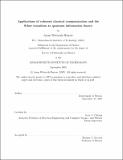Applications of coherent classical communication and the Schur transform to quantum information theory
Author(s)
Harrow, Aram (Aram Wettroth), 1980-
DownloadFull printable version (1.166Mb)
Other Contributors
Massachusetts Institute of Technology. Dept. of Physics.
Advisor
Isaac L. Chuang.
Terms of use
Metadata
Show full item recordAbstract
Quantum mechanics has led not only to new physical theories, but also a new understanding of information and computation. Quantum information not only yields new methods for achieving classical tasks such as factoring and key distribution but also suggests a completely new set of quantum problems, such as sending quantum information over quantum channels or efficiently performing particular basis changes on a quantum computer. This thesis contributes two new, purely quantum, tools to quantum information theory-coherent classical communication in the first half and an efficient quantum circuit for the Schur transform in the second half. The first part of this thesis (Chapters 1-4) is in fact built around two loosely overlapping themes. One is quantum Shannon theory, a broad class of coding theorems that includes Shannon and Schumacher data compression, channel coding, entanglement distillation and many others. The second, more specic, theme is the concept of using unitary quantum interactions to communicate between two parties. We begin by presenting new formalism: a general framework for Shannon theory that describes communication tasks in terms of fundamental information processing resources, such as entanglement and classical communication. Then we discuss communication with unitary gates and introduce the concept of coherent classical communication, in which classical messages are sent via some nearly unitary process. We find that coherent classical communication can be used to derive several new quantum protocols and unify them both conceptually and operationally with old ones. (cont.) Finally, we use these new protocols to prove optimal trade-o curves for a wide variety of coding problems in which a noisy channel or state is consumed and two noiseless resources are either consumed or generated at some rate. The second half of the thesis (Chapters 5-8) is based on the Schur transform, which maps between the computational basis of (Cd)n and a basis (known as the Schur basis) which simultaneously diagonalizes the commuting actions of the symmetric group Sn and the unitary group Ud. The Schur transform is used as a subroutine in many quantum communication protocols (which we review and further develop), but previously no polynomial-time quantum circuit for the Schur transform was known. We give such a polynomial-time quantum circuit based on the Clebsch-Gordan transform and then give algorithmic connections between the Schur transform and the quantum Fourier transform on Sn.
Description
Thesis (Ph. D.)--Massachusetts Institute of Technology, Dept. of Physics, 2005. This electronic version was submitted by the student author. The certified thesis is available in the Institute Archives and Special Collections. Includes bibliographical references (p. 167-176).
Date issued
2005Department
Massachusetts Institute of Technology. Department of PhysicsPublisher
Massachusetts Institute of Technology
Keywords
Physics.